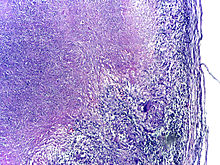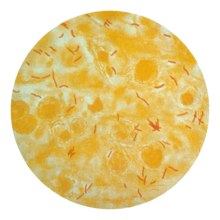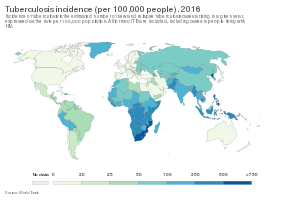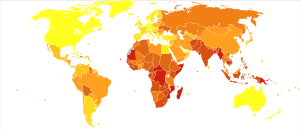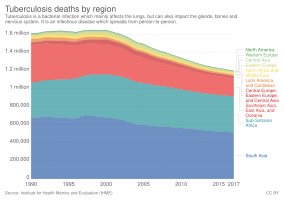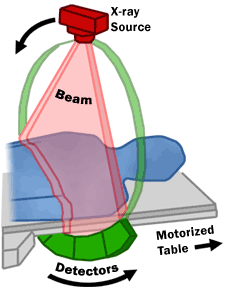| Tuberculosis | |
|---|---|
| Other names | Phthisis, phthisis pulmonalis, consumption |
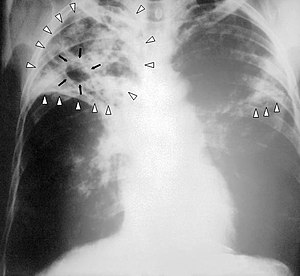 | |
| Chest X-ray of a person with advanced tuberculosis: Infection in both lungs is marked by white arrow-heads, and the formation of a cavity is marked by black arrows. | |
| Specialty | Infectious disease, pulmonology |
| Symptoms | Chronic cough, fever, cough with bloody mucus, weight loss |
| Causes | Mycobacterium tuberculosis |
| Risk factors | Smoking, HIV/AIDS |
| Diagnostic method | CXR, culture, tuberculin skin test |
| Differential diagnosis | Pneumonia, histoplasmosis, sarcoidosis, coccidioidomycosis |
| Prevention | Screening those at high risk, treatment of those infected, vaccination with bacillus Calmette-Guérin (BCG) |
| Treatment | Antibiotics |
| Frequency | 25% of people (latent TB) |
| Deaths | 1.5 million (2018) |
Tuberculosis (TB) is an infectious disease usually caused by Mycobacterium tuberculosis (MTB) bacteria. Tuberculosis generally affects the lungs, but can also affect other parts of the body. Most infections show no symptoms, in which case it is known as latent tuberculosis. About 10% of latent infections progress to active disease which, if left untreated, kills about half of those affected. The classic symptoms of active TB are a chronic cough with blood-containing mucus, fever, night sweats, and weight loss. It was historically called "consumption" due to the weight loss. Infection of other organs can cause a wide range of symptoms.
Tuberculosis is spread from one person to the next through the air when people who have active TB in their lungs cough, spit, speak, or sneeze. People with latent TB do not spread the disease. Active infection occurs more often in people with HIV/AIDS and in those who smoke. Diagnosis of active TB is based on chest X-rays, as well as microscopic examination and culture of body fluids. Diagnosis of latent TB relies on the tuberculin skin test (TST) or blood tests.
Prevention of TB involves screening those at high risk, early detection and treatment of cases, and vaccination with the bacillus Calmette-Guérin (BCG) vaccine. Those at high risk include household, workplace, and social contacts of people with active TB. Treatment requires the use of multiple antibiotics over a long period of time. Antibiotic resistance is a growing problem with increasing rates of multiple drug-resistant tuberculosis (MDR-TB) and extensively drug-resistant tuberculosis (XDR-TB).
As of 2018 one quarter of the world's population is thought to have latent infection with TB. New infections occur in about 1% of the population each year. In 2018, there were more than 10 million cases of active TB which resulted in 1.5 million deaths. This makes it the number one cause of death from an infectious disease. As of 2018, most TB cases occurred in the regions of South-East Asia (44%), Africa (24%) and the Western Pacific (18%), with more than 50% of cases being diagnosed in eight countries: India (27%), China (9%), Indonesia (8%), the Philippines (6%), Pakistan (6%), Nigeria (4%) and Bangladesh (4%). The number of new cases each year has decreased since 2000. About 80% of people in many Asian and African countries test positive while 5–10% of people in the United States population test positive by the tuberculin test. Tuberculosis has been present in humans since ancient times.
Signs and symptoms
The main symptoms of variants and stages of tuberculosis are given,
with many symptoms overlapping with other variants, while others are
more (but not entirely) specific for certain variants. Multiple variants
may be present simultaneously.
Tuberculosis may infect any part of the body, but most commonly occurs in the lungs (known as pulmonary tuberculosis).
Extrapulmonary TB occurs when tuberculosis develops outside of the
lungs, although extrapulmonary TB may coexist with pulmonary TB.
General signs and symptoms include fever, chills, night sweats, loss of appetite, weight loss, and fatigue. Significant nail clubbing may also occur.
Pulmonary
If a tuberculosis infection does become active, it most commonly involves the lungs (in about 90% of cases). Symptoms may include chest pain and a prolonged cough producing sputum. About 25% of people may not have any symptoms (i.e. they remain "asymptomatic"). Occasionally, people may cough up blood in small amounts, and in very rare cases, the infection may erode into the pulmonary artery or a Rasmussen's aneurysm, resulting in massive bleeding.
Tuberculosis may become a chronic illness and cause extensive scarring
in the upper lobes of the lungs. The upper lung lobes are more
frequently affected by tuberculosis than the lower ones. The reason for this difference is not clear. It may be due to either better air flow, or poor lymph drainage within the upper lungs.
Extrapulmonary
In 15–20% of active cases, the infection spreads outside the lungs, causing other kinds of TB. These are collectively denoted as "extrapulmonary tuberculosis". Extrapulmonary TB occurs more commonly in people with a weakened immune system and young children. In those with HIV, this occurs in more than 50% of cases. Notable extrapulmonary infection sites include the pleura (in tuberculous pleurisy), the central nervous system (in tuberculous meningitis), the lymphatic system (in scrofula of the neck), the genitourinary system (in urogenital tuberculosis), and the bones and joints (in Pott disease
of the spine), among others. A potentially more serious, widespread
form of TB is called "disseminated tuberculosis", it is also known as miliary tuberculosis. Miliary TB currently makes up about 10% of extrapulmonary cases.
Causes
Mycobacteria
Scanning electron micrograph of M. tuberculosis
The main cause of TB is Mycobacterium tuberculosis (MTB), a small, aerobic, nonmotile bacillus. The high lipid content of this pathogen accounts for many of its unique clinical characteristics. It divides every 16 to 20 hours, which is an extremely slow rate compared with other bacteria, which usually divide in less than an hour. Mycobacteria have an outer membrane lipid bilayer. If a Gram stain is performed, MTB either stains very weakly "Gram-positive" or does not retain dye as a result of the high lipid and mycolic acid content of its cell wall. MTB can withstand weak disinfectants and survive in a dry state for weeks. In nature, the bacterium can grow only within the cells of a host organism, but M. tuberculosis can be cultured in the laboratory.
Using histological stains on expectorated samples from phlegm
(also called "sputum"), scientists can identify MTB under a microscope.
Since MTB retains certain stains even after being treated with acidic
solution, it is classified as an acid-fast bacillus. The most common acid-fast staining techniques are the Ziehl–Neelsen stain and the Kinyoun stain, which dye acid-fast bacilli a bright red that stands out against a blue background. Auramine-rhodamine staining and fluorescence microscopy are also used.
The M. tuberculosis complex (MTBC) includes four other TB-causing mycobacteria: M. bovis, M. africanum, M. canetti, and M. microti. M. africanum is not widespread, but it is a significant cause of tuberculosis in parts of Africa. M. bovis was once a common cause of tuberculosis, but the introduction of pasteurized milk has almost completely eliminated this as a public health problem in developed countries. M. canetti is rare and seems to be limited to the Horn of Africa, although a few cases have been seen in African emigrants. M. microti is also rare and is seen almost only in immunodeficient people, although its prevalence may be significantly underestimated.
Other known pathogenic mycobacteria include M. leprae, M. avium, and M. kansasii. The latter two species are classified as "nontuberculous mycobacteria" (NTM). NTM cause neither TB nor leprosy, but they do cause lung diseases that resemble TB.
Risk factors
A number of factors make people more susceptible to TB infections.
The most important risk factor globally is HIV; 13% of all people with
TB are infected by the virus. This is a particular problem in sub-Saharan Africa, where rates of HIV are high. Of people without HIV who are infected with tuberculosis, about 5–10% develop active disease during their lifetimes; in contrast, 30% of those coinfected with HIV develop the active disease.
Tuberculosis is closely linked to both overcrowding and malnutrition, making it one of the principal diseases of poverty.
Those at high risk thus include: people who inject illicit drugs,
inhabitants and employees of locales where vulnerable people gather
(e.g. prisons and homeless shelters), medically underprivileged and
resource-poor communities, high-risk ethnic minorities, children in
close contact with high-risk category patients, and health-care
providers serving these patients.
Chronic lung disease is another significant risk factor. Silicosis increases the risk about 30-fold. Those who smoke cigarettes have nearly twice the risk of TB compared to nonsmokers.
Other disease states can also increase the risk of developing tuberculosis. These include alcoholism and diabetes mellitus (three-fold increase).
Certain medications, such as corticosteroids and infliximab (an anti-αTNF monoclonal antibody), are other important risk factors, especially in the developed world.
Genetic susceptibility also exists, for which the overall importance remains undefined.
Mechanism
Public health campaigns in the 1920s tried to halt the spread of TB.
Transmission
When people with active pulmonary TB cough, sneeze, speak, sing, or spit, they expel infectious aerosol droplets 0.5 to 5.0 µm in diameter. A single sneeze can release up to 40,000 droplets.
Each one of these droplets may transmit the disease, since the
infectious dose of tuberculosis is very small (the inhalation of fewer
than 10 bacteria may cause an infection).
People with prolonged, frequent, or close contact with people
with TB are at particularly high risk of becoming infected, with an
estimated 22% infection rate. A person with active but untreated tuberculosis may infect 10–15 (or more) other people per year. Transmission should occur from only people with active TB – those with latent infection are not thought to be contagious.
The probability of transmission from one person to another depends upon
several factors, including the number of infectious droplets expelled
by the carrier, the effectiveness of ventilation, the duration of
exposure, the virulence of the M. tuberculosis strain, the level of immunity in the uninfected person, and others.
The cascade of person-to-person spread can be circumvented by
segregating those with active ("overt") TB and putting them on anti-TB
drug regimens. After about two weeks of effective treatment, subjects
with nonresistant active infections generally do not remain contagious to others.
If someone does become infected, it typically takes three to four weeks
before the newly infected person becomes infectious enough to transmit
the disease to others.
Pathogenesis
Microscopy of tuberculous epididymitis. H&E stain
About 90% of those infected with M. tuberculosis have asymptomatic, latent TB infections (sometimes called LTBI), with only a 10% lifetime chance that the latent infection will progress to overt, active tuberculous disease. In those with HIV, the risk of developing active TB increases to nearly 10% a year. If effective treatment is not given, the death rate for active TB cases is up to 66%.
TB infection begins when the mycobacteria reach the alveolar air sacs of the lungs, where they invade and replicate within endosomes of alveolar macrophages. Macrophages identify the bacterium as foreign and attempt to eliminate it by phagocytosis.
During this process, the bacterium is enveloped by the macrophage and
stored temporarily in a membrane-bound vesicle called a phagosome. The
phagosome then combines with a lysosome to create a phagolysosome. In
the phagolysosome, the cell attempts to use reactive oxygen species and acid to kill the bacterium. However, M. tuberculosis has a thick, waxy mycolic acid capsule that protects it from these toxic substances. M. tuberculosis is able to reproduce inside the macrophage and will eventually kill the immune cell.
The primary site of infection in the lungs, known as the "Ghon focus", is generally located in either the upper part of the lower lobe, or the lower part of the upper lobe. Tuberculosis of the lungs may also occur via infection from the blood stream. This is known as a Simon focus and is typically found in the top of the lung.
This hematogenous transmission can also spread infection to more
distant sites, such as peripheral lymph nodes, the kidneys, the brain,
and the bones. All parts of the body can be affected by the disease, though for unknown reasons it rarely affects the heart, skeletal muscles, pancreas, or thyroid.
Robert Carswell's illustration of tubercle
Tuberculosis is classified as one of the granulomatous inflammatory diseases. Macrophages, epithelioid cells, T lymphocytes, B lymphocytes, and fibroblasts aggregate to form granulomas, with lymphocytes
surrounding the infected macrophages. When other macrophages attack the
infected macrophage, they fuse together to form a giant multinucleated
cell in the alveolar lumen. The granuloma may prevent dissemination of
the mycobacteria and provide a local environment for interaction of
cells of the immune system.
However, more recent evidence suggests that the bacteria use the
granulomas to avoid destruction by the host's immune system.
Macrophages and dendritic cells in the granulomas are unable to present antigen to lymphocytes; thus the immune response is suppressed.
Bacteria inside the granuloma can become dormant, resulting in latent
infection. Another feature of the granulomas is the development of
abnormal cell death (necrosis) in the center of tubercles. To the naked eye, this has the texture of soft, white cheese and is termed caseous necrosis.
If TB bacteria gain entry to the blood stream from an area of
damaged tissue, they can spread throughout the body and set up many foci
of infection, all appearing as tiny, white tubercles in the tissues. This severe form of TB disease, most common in young children and those with HIV, is called miliary tuberculosis. People with this disseminated TB have a high fatality rate even with treatment (about 30%).
In many people, the infection waxes and wanes. Tissue destruction and necrosis are often balanced by healing and fibrosis.
Affected tissue is replaced by scarring and cavities filled with
caseous necrotic material. During active disease, some of these cavities
are joined to the air passages (bronchi)
and this material can be coughed up. It contains living bacteria, and
thus can spread the infection. Treatment with appropriate antibiotics kills bacteria and allows healing to take place. Upon cure, affected areas are eventually replaced by scar tissue.
Diagnosis
M. tuberculosis (stained red) in sputum
Active tuberculosis
Diagnosing active tuberculosis based only on signs and symptoms is difficult, as is diagnosing the disease in those who have a weakened immune system. A diagnosis of TB should, however, be considered in those with signs of lung disease or constitutional symptoms lasting longer than two weeks. A chest X-ray and multiple sputum cultures for acid-fast bacilli are typically part of the initial evaluation. Interferon-γ release assays and tuberculin skin tests are of little use in most of the developing world. Interferon gamma release assays (IGRA) have similar limitations in those with HIV.
A definitive diagnosis of TB is made by identifying M. tuberculosis in a clinical sample (e.g., sputum, pus, or a tissue biopsy). However, the difficult culture process for this slow-growing organism can take two to six weeks for blood or sputum culture. Thus, treatment is often begun before cultures are confirmed.
Nucleic acid amplification tests and adenosine deaminase testing may allow rapid diagnosis of TB. These tests, however, are not routinely recommended, as they rarely alter how a person is treated. Blood tests to detect antibodies are not specific or sensitive, so they are not recommended.
Latent tuberculosis
The Mantoux tuberculin skin test is often used to screen people at high risk for TB. Those who have been previously immunized with the Bacille Calmette-Guerin vaccine may have a false-positive test result. The test may be falsely negative in those with sarcoidosis, Hodgkin's lymphoma, malnutrition, and most notably, active tuberculosis. Interferon gamma release assays, on a blood sample, are recommended in those who are positive to the Mantoux test. These are not affected by immunization or most environmental mycobacteria, so they generate fewer false-positive results. However, they are affected by M. szulgai, M. marinum, and M. kansasii.
IGRAs may increase sensitivity when used in addition to the skin test,
but may be less sensitive than the skin test when used alone.
The US Preventive Services Task Force
(USPSTF) has recommended screening people who are at high risk for
latent tuberculosis with either tuberculin skin tests or
interferon-gamma release assays. While some have recommend testing health care workers, evidence of benefit for this is poor as of 2019. The Centers for Disease Control and Prevention (CDC) stopped recommending yearly testing of health care workers without known exposure in 2019.
Prevention
Tuberculosis prevention poster from the United States, c. 1940
Tuberculosis prevention and control efforts rely primarily on the
vaccination of infants and the detection and appropriate treatment of
active cases. The World Health Organization (WHO) has achieved some success with improved treatment regimens, and a small decrease in case numbers.
Vaccines
The only available vaccine as of 2011 is Bacillus Calmette-Guérin (BCG).
In children it decreases the risk of getting the infection by 20% and
the risk of infection turning into active disease by nearly 60%.
It is the most widely used vaccine worldwide, with more than 90% of all children being vaccinated. The immunity it induces decreases after about ten years.
As tuberculosis is uncommon in most of Canada, Western Europe, and the
United States, BCG is administered to only those people at high risk.
Part of the reasoning against the use of the vaccine is that it makes
the tuberculin skin test falsely positive, reducing the test's
usefulness as a screening tool. Several vaccines are being developed.
Intradermal MVA85A Vaccine in addition to BCG injection is not effective in preventing tuberculosis.
Public health
The World Health Organization (WHO) declared TB a "global health emergency" in 1993, and in 2006, the Stop TB Partnership developed a Global Plan to Stop Tuberculosis that aimed to save 14 million lives between its launch and 2015.
A number of targets they set were not achieved by 2015, mostly due to
the increase in HIV-associated tuberculosis and the emergence of
multiple drug-resistant tuberculosis. A tuberculosis classification system developed by the American Thoracic Society is used primarily in public health programs.
The benefits and risks of giving anti-tubercular drugs in those exposed to MDR-TB is unclear.
Treatment
Treatment of TB uses antibiotics to kill the bacteria. Effective TB
treatment is difficult, due to the unusual structure and chemical
composition of the mycobacterial cell wall, which hinders the entry of
drugs and makes many antibiotics ineffective.
Active TB is best treated with combinations of several antibiotics to reduce the risk of the bacteria developing antibiotic resistance. The routine use of rifabutin instead of rifampicin in HIV-positive people with tuberculosis is of unclear benefit as of 2007.
Latent
Latent TB is treated with either isoniazid or rifampin alone, or a combination of isoniazid with either rifampicin or rifapentine.
The treatment takes three to nine months depending on the medications used [People with latent infections are treated to prevent them from progressing to active TB disease later in life.
Education or counselling may improve the latent tuberculosis treatment completion rates.
New onset
The recommended treatment of new-onset pulmonary tuberculosis, as of 2010, is six months of a combination of antibiotics containing rifampicin, isoniazid, pyrazinamide, and ethambutol for the first two months, and only rifampicin and isoniazid for the last four months. Where resistance to isoniazid is high, ethambutol may be added for the last four months as an alternative.
Treatment with anti-TB drugs for at least 6 months results in higher
success rates when compared with treatment less than 6 months; even
though the difference is small. Shorter treatment regimen may be
recommended for those with compliance issues. There is also no evidence to support shorter anti-tubeculosis treatment regimen when compared to 6 months treatment regimen.
Recurrent disease
If tuberculosis recurs, testing to determine which antibiotics it is sensitive to is important before determining treatment. If multiple drug-resistant TB (MDR-TB) is detected, treatment with at least four effective antibiotics for 18 to 24 months is recommended.
Medication administration
Directly observed therapy,
i.e., having a health care provider watch the person take their
medications, is recommended by the World Health Organization (WHO) in an
effort to reduce the number of people not appropriately taking
antibiotics. The evidence to support this practice over people simply taking their medications independently is of poor quality.
There is no strong evidence indicating that directly observed therapy
improves the number of people who were cured or the number of people who
complete their medicine.
Moderate quality evidence suggests that there is also no difference if
people are observed at home versus at a clinic, or by a family member
versus a health care worker. Methods to remind people of the importance of treatment and appointments may result in a small but important improvement.
There is also not enough evidence to support intermittent
rifampicin-containing therapy given two to three times a week has equal
effectiveness as daily dose regimen on improving cure rates and reducing
relapsing rates.
There is also not enough evidence on effectiveness of giving
intermittent twice or thrice weekly short course regimen compared to
daily dosing regimen in treating children with tuberculosis.
Medication resistance
Primary resistance occurs when a person becomes infected with a resistant strain of TB. A person with fully susceptible MTB
may develop secondary (acquired) resistance during therapy because of
inadequate treatment, not taking the prescribed regimen appropriately
(lack of compliance), or using low-quality medication.
Drug-resistant TB is a serious public health issue in many developing
countries, as its treatment is longer and requires more expensive drugs.
MDR-TB is defined as resistance to the two most effective first-line TB
drugs: rifampicin and isoniazid. Extensively drug-resistant TB is also
resistant to three or more of the six classes of second-line drugs. Totally drug-resistant TB is resistant to all currently used drugs. It was first observed in 2003 in Italy, but not widely reported until 2012, and has also been found in Iran and India. Bedaquiline is tentatively supported for use in multiple drug-resistant TB.
XDR-TB is a term sometimes used to define extensively resistant TB, and constitutes one in ten cases of MDR-TB. Cases of XDR TB have been identified in more than 90% of countries.
There is some efficacy for linezolid to treat those with XDR-TB but
side effects and discontinuation of medications were common.
For those with known rifampicin or MDR-TB, Genotype® MTBDRsl
Assay performed on culture isolates or smear positive specimens may be
useful to detect second-line anti-tubercular drug resistance.
Prognosis
Age-standardized disability-adjusted life years caused by tuberculosis per 100,000 inhabitants in 2004.
|
no data
≤10
10–25
25–50
50–75
75–100
100–250
|
250–500
500–750
750–1000
1000–2000
2000–3000
≥ 3000
|
Progression from TB infection to overt TB disease occurs when the
bacilli overcome the immune system defenses and begin to multiply. In
primary TB disease (some 1–5% of cases), this occurs soon after the
initial infection. However, in the majority of cases, a latent infection occurs with no obvious symptoms. These dormant bacilli produce active tuberculosis in 5–10% of these latent cases, often many years after infection.
The risk of reactivation increases with immunosuppression, such as that caused by infection with HIV. In people coinfected with M. tuberculosis and HIV, the risk of reactivation increases to 10% per year. Studies using DNA fingerprinting of M. tuberculosis strains have shown reinfection contributes more substantially to recurrent TB than previously thought, with estimates that it might account for more than 50% of reactivated cases in areas where TB is common. The chance of death from a case of tuberculosis is about 4% as of 2008, down from 8% in 1995.
Epidemiology
Roughly one-quarter of the world's population has been infected with M. tuberculosis, with new infections occurring in about 1% of the population each year. However, most infections with M. tuberculosis do not cause TB disease, and 90–95% of infections remain asymptomatic. In 2012, an estimated 8.6 million chronic cases were active. In 2010, 8.8 million new cases of TB were diagnosed, and 1.20–1.45 million deaths occurred, most of these occurring in developing countries. Of these 1.45 million deaths, about 0.35 million occur in those also infected with HIV.
In 2018, tuberculosis was the leading cause of death worldwide from a single infectious agent. The total number of tuberculosis cases has been decreasing since 2005, while new cases have decreased since 2002. China has achieved particularly dramatic progress, with about an 80% reduction in its TB mortality rate between 1990 and 2010. The number of new cases has declined by 17% between 2004 and 2014.
Tuberculosis is more common in developing countries; about 80% of the
population in many Asian and African countries test positive in
tuberculin tests, while only 5–10% of the US population test positive.
Hopes of totally controlling the disease have been dramatically
dampened because of a number of factors, including the difficulty of
developing an effective vaccine, the expensive and time-consuming
diagnostic process, the necessity of many months of treatment, the
increase in HIV-associated tuberculosis, and the emergence of
drug-resistant cases in the 1980s.
In 2007, the country with the highest estimated incidence rate of TB was Swaziland, with 1,200 cases per 100,000 people. India had the largest total incidence, with an estimated 2.0 million new cases.
In developed countries, tuberculosis is less common and is found mainly
in urban areas. Rates per 100,000 people in different areas of the
world were: globally 178, Africa 332, the Americas 36, Eastern
Mediterranean 173, Europe 63, Southeast Asia 278, and Western Pacific
139 in 2010. In Canada and Australia, tuberculosis is many times more common among the aboriginal peoples, especially in remote areas. In the United States Native Americans have a fivefold greater mortality from TB, and racial and ethnic minorities accounted for 84% of all reported TB cases.
The rate of TB varies with age. In Africa, it primarily affects adolescents and young adults.
However, in countries where incidence rates have declined dramatically
(such as the United States), TB is mainly a disease of older people and
the immunocompromised (risk factors are listed above). Worldwide, 22 "high-burden" states or countries together experience 80% of cases as well as 83% of deaths.
History
Egyptian mummy in the British Museum – tubercular decay has been found in the spine.
Tuberculosis has existed since antiquity. The oldest unambiguously detected M. tuberculosis gives evidence of the disease in the remains of bison in Wyoming dated to around 17,000 years ago.
However, whether tuberculosis originated in bovines, then transferred
to humans, or whether both bovine and human tuberculosis diverged from a
common ancestor, remains unclear. A comparison of the genes of M. tuberculosis
complex (MTBC) in humans to MTBC in animals suggests humans did not
acquire MTBC from animals during animal domestication, as researchers
previously believed. Both strains of the tuberculosis bacteria share a
common ancestor, which could have infected humans even before the Neolithic Revolution. Skeletal remains show some prehistoric humans (4000 BC) had TB, and researchers have found tubercular decay in the spines of Egyptian mummies dating from 3000 to 2400 BC. Genetic studies suggest the presence of TB in the Americas from about 100 AD.
Before the Industrial Revolution, folklore often associated tuberculosis with vampires.
When one member of a family died from the disease, the other infected
members would lose their health slowly. People believed this was caused
by the original person with TB draining the life from the other family
members.
Although Richard Morton established the pulmonary form associated with tubercles as a pathology in 1689, due to the variety of its symptoms, TB was not identified as a single disease until the 1820s. J. L. Schönlein coined the name "tuberculosis" in 1839. Between 1838 and 1845, Dr. John Croghan, the owner of Mammoth Cave
in Kentucky from 1839 onwards, brought a number of people with
tuberculosis into the cave in the hope of curing the disease with the
constant temperature and purity of the cave air; each died within a
year. Hermann Brehmer opened the first TB sanatorium in 1859 in Görbersdorf (now Sokołowsko) in Silesia.
Robert Koch discovered the tuberculosis bacillus.
Robert Koch identified and described the bacillus causing tuberculosis, M. tuberculosis, on 24 March 1882. He received the Nobel Prize in physiology or medicine in 1905 for this discovery.
Koch did not believe the cattle and human tuberculosis diseases were
similar, which delayed the recognition of infected milk as a source of
infection. During the first half of the 1900s the risk of transmission
from this source was dramatically reduced after the application of the pasteurization process. Koch announced a glycerine
extract of the tubercle bacilli as a "remedy" for tuberculosis in 1890,
calling it "tuberculin". Although it was not effective, it was later
successfully adapted as a screening test for the presence of
pre-symptomatic tuberculosis. World Tuberculosis Day is marked on 24 March each year, the anniversary of Koch's original scientific announcement.
Albert Calmette and Camille Guérin
achieved the first genuine success in immunization against tuberculosis
in 1906, using attenuated bovine-strain tuberculosis. It was called bacille Calmette–Guérin (BCG). The BCG vaccine was first used on humans in 1921 in France, but achieved widespread acceptance in the US, Great Britain, and Germany only after World War II.
Tuberculosis caused widespread public concern in the 19th and
early 20th centuries as the disease became common among the urban poor.
In 1815 one in four deaths in England was due to "consumption". By 1918,
TB still caused one in six deaths in France. After TB was determined to
be contagious, in the 1880s, it was put on a notifiable-disease
list in Britain; campaigns started to stop people from spitting in
public places, and the infected poor were "encouraged" to enter sanatoria that resembled prisons (the sanatoria for the middle and upper classes offered excellent care and constant medical attention).
Whatever the benefits of the "fresh air" and labor in the sanatoria,
even under the best conditions, 50% of those who entered died within
five years (c. 1916). When the Medical Research Council formed in Britain in 1913, it initially focused on tuberculosis research.
In Europe, rates of tuberculosis began to rise in the early 1600s
to a peak level in the 1800s, when it caused nearly 25% of all deaths. By the 1950s mortality in Europe had decreased about 90%.
Improvements in sanitation, vaccination, and other public-health
measures began significantly reducing rates of tuberculosis even before
the arrival of streptomycin and other antibiotics, although the disease remained a significant threat.
In 1946 the development of the antibiotic streptomycin made effective
treatment and cure of TB a reality. Prior to the introduction of this
medication, the only treatment was surgical intervention, including the "pneumothorax technique", which involved collapsing an infected lung to "rest" it and to allow tuberculous lesions to heal.
Because of the emergence of MDR-TB, surgery has been
re-introduced for certain cases of TB infections. It involves the
removal of infected chest cavities ("bullae") in the lungs to reduce the
number of bacteria and to increase exposure of the remaining bacteria
to antibiotics in the bloodstream. Hopes of completely eliminating TB ended with the rise of drug-resistant
strains in the 1980s. The subsequent resurgence of tuberculosis
resulted in the declaration of a global health emergency by the World
Health Organization (WHO) in 1993.
Society and culture
Names
Tuberculosis has been known by many names from the technical to the familiar. Phthisis (Φθισις) is a Greek word for consumption, an old term for pulmonary tuberculosis; around 460 BCE, Hippocrates described phthisis as a disease of dry seasons. The abbreviation "TB" is short for tubercle bacillus.
"Consumption" was the most common nineteenth century English word for
the disease. The Latin root "con" meaning "completely" is linked to
"sumere" meaning "to take up from under." In The Life and Death of Mr Badman by John Bunyan, the author calls consumption "the captain of all these men of death." "Great white plague" has also been used.
Art and literature
Painting The Sick Child by Edvard Munch,
1885–86, depicts the illness of his sister Sophie, who died of
tuberculosis when Edvard was 14; his mother too died of the disease.
Tuberculosis was for centuries associated with poetic and artistic qualities among those infected, and was also known as "the romantic disease". Major artistic figures such as the poets John Keats, Percy Bysshe Shelley, and Edgar Allan Poe, the composer Frédéric Chopin, the playwright Anton Chekhov, the novelists Franz Kafka, Katherine Mansfield, Charlotte Brontë, Fyodor Dostoevsky, Thomas Mann, W. Somerset Maugham, George Orwell, and Robert Louis Stevenson, and the artists Alice Neel, Jean-Antoine Watteau, Elizabeth Siddal, Marie Bashkirtseff, Edvard Munch, Aubrey Beardsley and Amedeo Modigliani
either had the disease or were surrounded by people who did. A
widespread belief was that tuberculosis assisted artistic talent.
Physical mechanisms proposed for this effect included the slight fever
and toxaemia that it caused, allegedly helping them to see life more
clearly and to act decisively.
Tuberculosis formed an often-reused theme in literature, as in Thomas Mann's The Magic Mountain, set in a sanatorium; in music, as in Van Morrison's song "T.B. Sheets"; in opera, as in Puccini's La bohème and Verdi's La Traviata; in art, as in Monet's painting of his first wife Camille on her deathbed; and in film, such as the 1945 The Bells of St. Mary's starring Ingrid Bergman as a nun with tuberculosis.
Public health efforts
The World Health Organization (WHO), the Bill and Melinda Gates Foundation,
and the U.S. government are subsidizing a fast-acting diagnostic
tuberculosis test for use in low- and middle-income countries as of
2012.
In addition to being fast-acting, the test can determine if there is
resistance to the antibiotic rifampicin which may indicate multi-drug
resistant tuberculosis and is accurate in those who are also infected
with HIV. Many resource-poor places as of 2011 have access to only sputum microscopy.
India had the highest total number of TB cases worldwide in 2010,
in part due to poor disease management within the private and public
health care sector. Programs such as the Revised National Tuberculosis Control Program are working to reduce TB levels among people receiving public health care.
A 2014 the EIU-healthcare
report finds there is a need to address apathy and urges for increased
funding. The report cites among others Lucica Ditui "[TB] is like an
orphan. It has been neglected even in countries with a high burden and
often forgotten by donors and those investing in health interventions."
Slow progress has led to frustration, expressed by the executive director of the Global Fund to Fight AIDS, Tuberculosis and Malaria – Mark Dybul: "we have the tools to end TB as a pandemic and public health threat on the planet, but we are not doing it."
Several international organizations are pushing for more transparency
in treatment, and more countries are implementing mandatory reporting of
cases to the government as of 2014, although adherence is often
variable. Commercial treatment providers may at times overprescribe
second-line drugs as well as supplementary treatment, promoting demands
for further regulations. The government of Brazil provides universal TB-care, which reduces this problem.
Conversely, falling rates of TB-infection may not relate to the number
of programs directed at reducing infection rates but may be tied to
increased level of education, income, and health of the population. Costs of the disease, as calculated by the World Bank in 2009 may exceed US$150 billion per year in "high burden" countries. Lack of progress eradicating the disease may also be due to lack of patient follow-up – as among the 250M rural migrants in China.
There is insufficient data to show that active contact tracing helps to improve case detection rates for tuberculosis.
Interventions such as house-to-house visits, educational leaflets, mass
media strategies, educational sessions may increase tuberculosis
detection rates in short-term.
There is no study that compare new method of contact tracing such as
social network analysis with existing contact tracing methods.
Stigma
Slow progress in preventing the disease may in part be due to stigma associated with TB.
Stigma may be due to the fear of transmission from affected
individuals. This stigma may additionally arise due to links between TB
and poverty, and in Africa, AIDS.
Such stigmatization may be both real and perceived; for example, in
Ghana individuals with TB are banned from attending public gatherings.
Stigma towards TB may result in delays in seeking treatment, lower treatment compliance, and family members keeping cause of death secret – allowing the disease to spread further. In contrast, in Russia stigma was associated with increased treatment compliance. TB stigma also affects socially marginalized individuals to a greater degree and varies between regions.
One way to decrease stigma may be through the promotion of "TB
clubs", where those infected may share experiences and offer support, or
through counseling.
Some studies have shown TB education programs to be effective in
decreasing stigma, and may thus be effective in increasing treatment
adherence. Despite this, studies on the relationship between reduced stigma and mortality are lacking as of 2010, and similar efforts to decrease stigma surrounding AIDS have been minimally effective.
Some have claimed the stigma to be worse than the disease, and
healthcare providers may unintentionally reinforce stigma, as those with
TB are often perceived as difficult or otherwise undesirable. A greater understanding of the social and cultural dimensions of tuberculosis may also help with stigma reduction.
Research
The BCG vaccine has limitations, and research to develop new TB vaccines is ongoing. A number of potential candidates are currently in phase I and II clinical trials.
Two main approaches are used to attempt to improve the efficacy of
available vaccines. One approach involves adding a subunit vaccine to
BCG, while the other strategy is attempting to create new and better
live vaccines. MVA85A, an example of a subunit vaccine, is in trials in South Africa as of 2006, is based on a genetically modified vaccinia virus. Vaccines are hoped to play a significant role in treatment of both latent and active disease.
To encourage further discovery, researchers and policymakers are
promoting new economic models of vaccine development as of 2006,
including prizes, tax incentives, and advance market commitments. A number of groups, including the Stop TB Partnership, the South African Tuberculosis Vaccine Initiative, and the Aeras Global TB Vaccine Foundation, are involved with research. Among these, the Aeras Global TB Vaccine Foundation received a gift of more than $280 million (US) from the Bill and Melinda Gates Foundation to develop and license an improved vaccine against tuberculosis for use in high burden countries.
A number of medications are being studied as of 2012 for multidrug-resistant tuberculosis, including bedaquiline and delamanid. Bedaquiline received U.S. Food and Drug Administration (FDA) approval in late 2012.
The safety and effectiveness of these new agents are uncertain as of
2012, because they are based on the results of relatively small studies.
However, existing data suggest that patients taking bedaquiline in
addition to standard TB therapy are five times more likely to die than
those without the new drug,
which has resulted in medical journal articles raising health policy
questions about why the FDA approved the drug and whether financial ties
to the company making bedaquiline influenced physicians' support for
its use.
Steroids add-on therapy has not shown any benefits for people with active pulmonary tuberculosis infection.
Other animals
Mycobacteria infect many different animals, including birds, fish, rodents, and reptiles. The subspecies Mycobacterium tuberculosis, though, is rarely present in wild animals. An effort to eradicate bovine tuberculosis caused by Mycobacterium bovis from the cattle and deer herds of New Zealand has been relatively successful. Efforts in Great Britain have been less successful.
As of 2015, tuberculosis appears to be widespread among captive elephants in the US. It is believed that the animals originally acquired the disease from humans, a process called reverse zoonosis.
Because the disease can spread through the air to infect both humans
and other animals, it is a public health concern affecting circuses and zoos.



